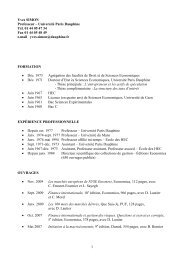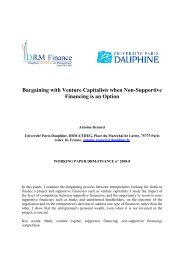Corporate governance and earnings management ... - CEREG
Corporate governance and earnings management ... - CEREG
Corporate governance and earnings management ... - CEREG
Create successful ePaper yourself
Turn your PDF publications into a flip-book with our unique Google optimized e-Paper software.
Arthur Andersen came to the defense of these companies, <strong>and</strong> through its main spokesmen,<br />
Catlett, Olson <strong>and</strong> Spacek, brought back the static theory: goodwill was not a (true) asset. It<br />
was instead the unstable result of simple expectation, <strong>and</strong> as such should be removed from the<br />
balance sheet immediately by charging to reserves or capital (Catlett & Olson, 1968).<br />
Interestingly, these authors are taking up one of the fundamental arguments of the static<br />
doctrine, that it is impossible to sell the goodwill separately: “the goodwill of a business may<br />
be different in nature from the other elements in the value of the business in that goodwill is<br />
not separable in the sense of being saleable apart from the business as a whole” (Catlett &<br />
Olson, 1968, p. 12). Colley <strong>and</strong> Volkan (1988, p. 41) are also in favor of writing off goodwill<br />
against equity, for the unidentifiable portion of the excess payment over fair values of net<br />
assets acquired, the identifiable part being capitalized <strong>and</strong> amortized. Miller (1973, p. 280,<br />
291), who contends that recorded goodwill exists because of an inadequate theory of<br />
aggregation of assets, concludes that “the least harmful resolution appears to lie in the<br />
immediate write-off against income”.<br />
As one commentator on Catlett <strong>and</strong> Olson’s work remarked, their reasoning appears to be<br />
“resurrecting the spirit of the late 20’s <strong>and</strong> early 30’s, when in the interest of conservatism, it<br />
was popular to write off anything that might embarrass future reported results” (Defliese, in<br />
Catlett & Olson, 1968, p. 118). In fact, despite appearances, the spirit of their thinking is very<br />
different from the 1930s. In preferring a write-off against capital to a write-off against<br />
reserves (1968, p. 92), Catlett <strong>and</strong> Olson are not really in line with the static approach. It is as<br />
if the static doctrine was used only as an excuse for a particular objective – to avoid any drain<br />
on profits – that has nothing to do with its traditional purpose.<br />
In parallel to the “doctrinal resistance”, pressure was put on members of the APB, with a<br />
certain degree of success. The result was a “modern” <strong>and</strong> “beneficial” version of the static<br />
solution: pooling of interests. Until 1950, the only business combination method that existed<br />
was the purchase accounting method (Catlett & Olson, 1968, p. 45). Pooling of interests was<br />
47



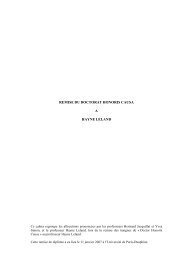

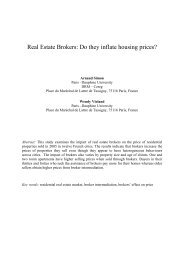
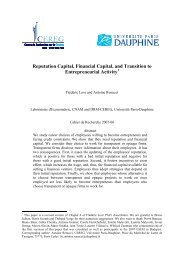

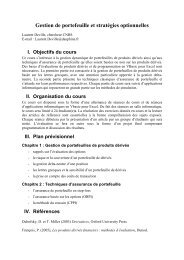



![& 6 ] ^ F ]^ - CEREG - Université Paris-Dauphine](https://img.yumpu.com/33326502/1/184x260/-6-f-cereg-universitac-paris-dauphine.jpg?quality=85)

